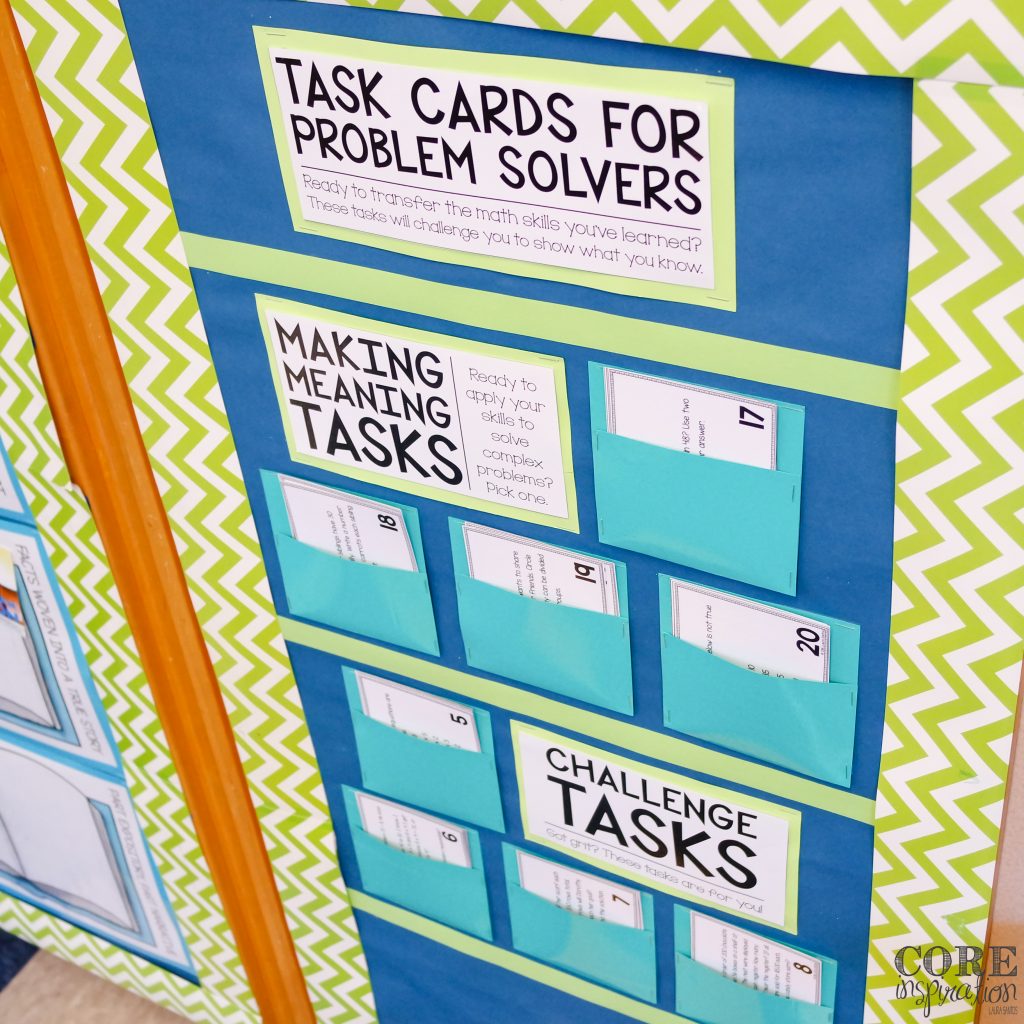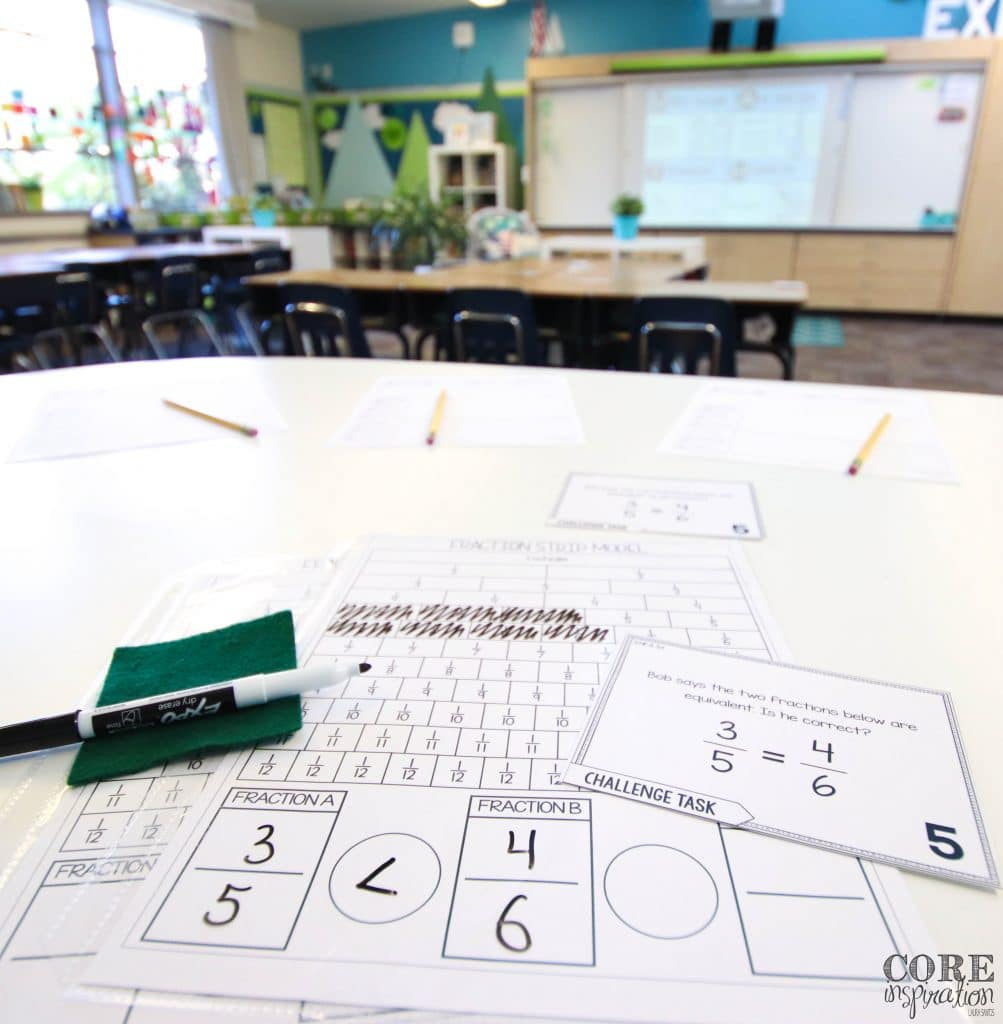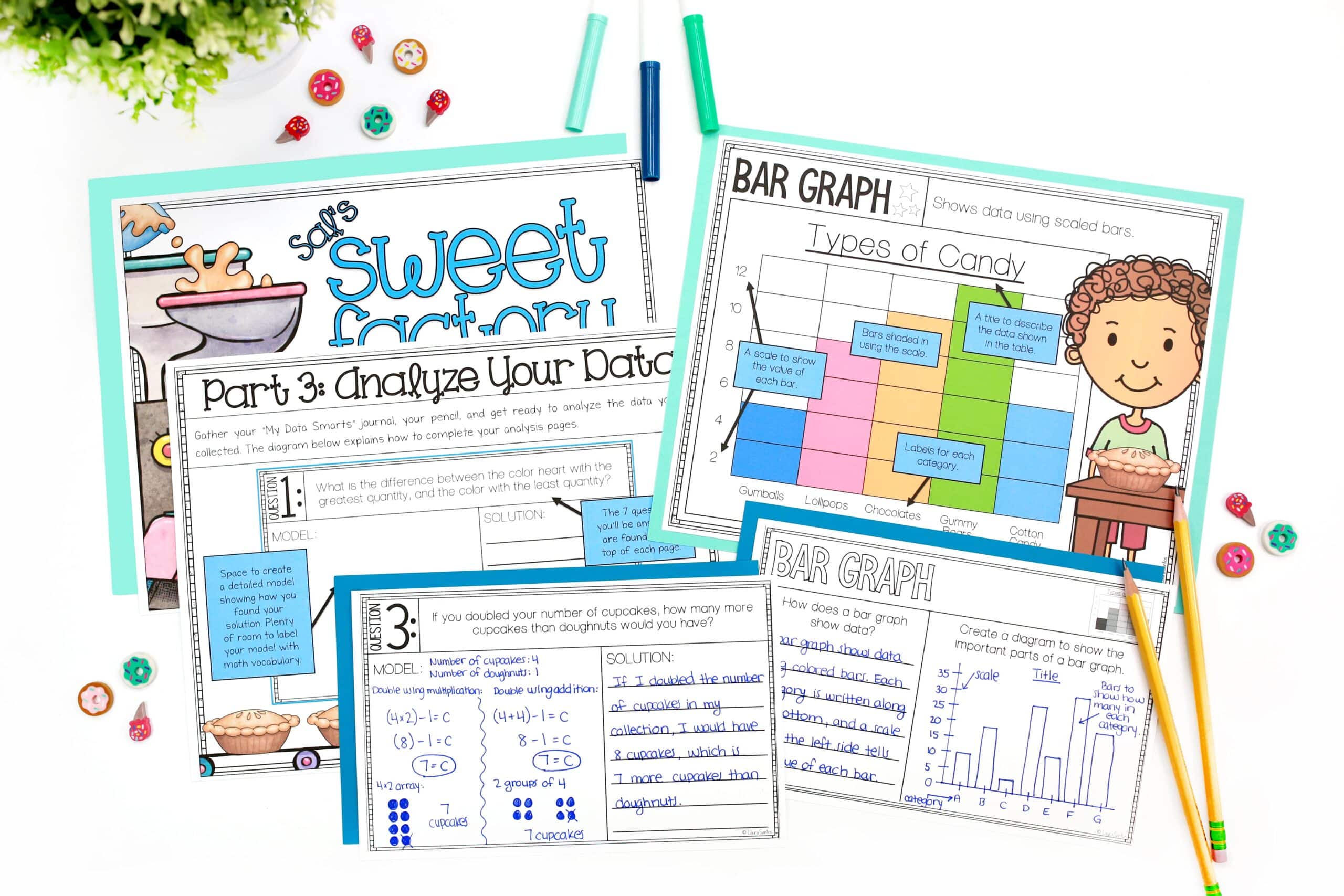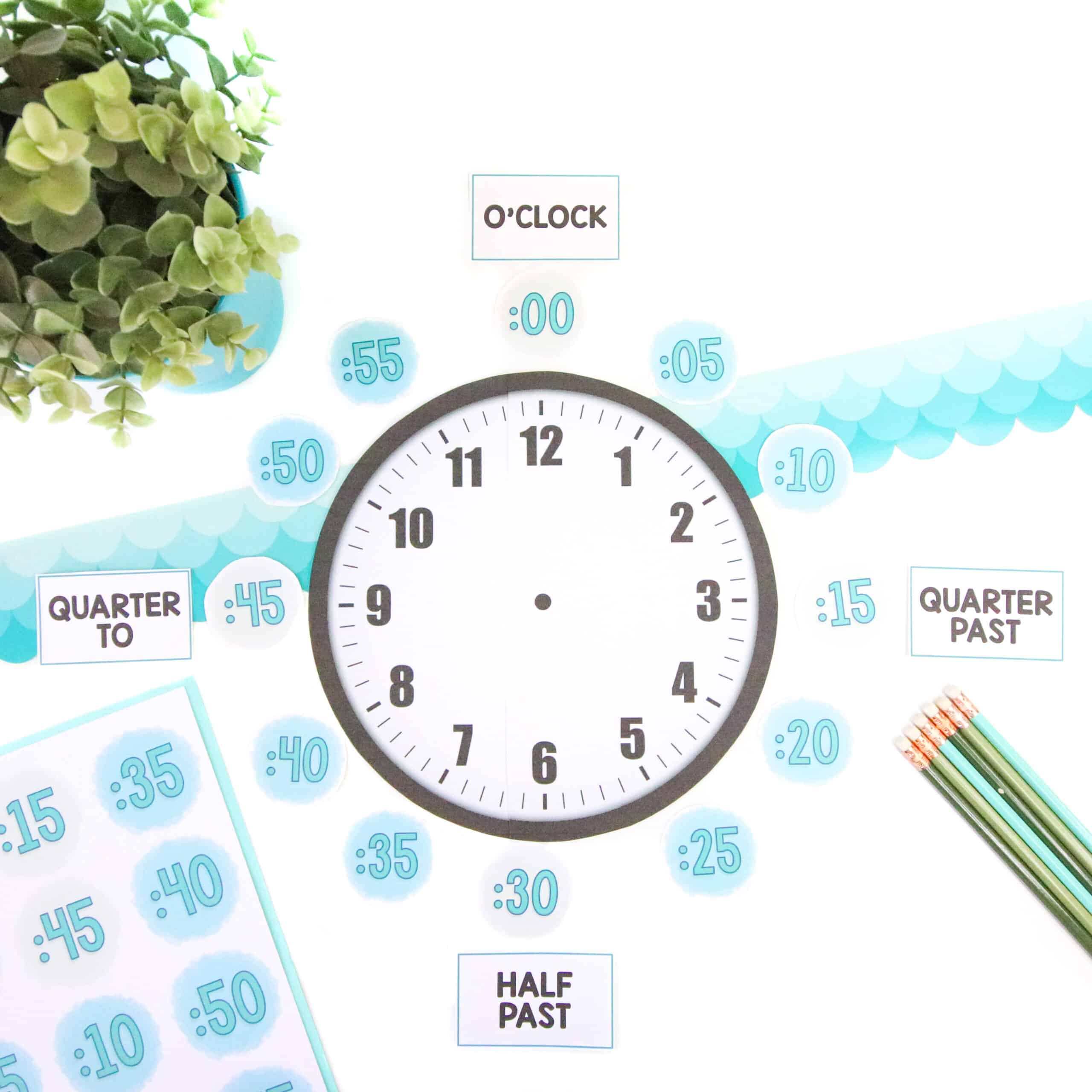Math Problem Solving Task Cards are one of the most productive tools for helping students build a deeper understanding of math concepts. These unique task cards include a variety of word problems that require students to utilize problem solving skills, critical thinking, precise modeling, and get routine practice with explaining their reasoning. Each day during Math Workshop, students are given time to work on these rigorous task so they can connect the math skills they are learning to real world situations.
This post contains affiliate links for which I may make a small commission at no extra cost to you should you make a purchase.

To make the most of this tool, and rapidly build your students’ problem solving skills, it is essential that students are given time to engage with these tasks on a routine basis. This post includes a break down of the math task card routines and expectations I have used for years in my second and third grade classes, which can be adapted and used in your elementary classroom this coming week.
When Do Students Work On Task Cards?
During the At Your Seat rotation of Math Workshop each day, students are given time to work on their task cards. First, students complete a short exit slip-style assignment that directly aligns to the mini lesson taught that day. In my classroom, this assignment has always come directly from our district-adopted curriculum. That assignment is completed, checked, and placed in the homework folder (the backside of this sheet is nightly homework due the following day).

Then, students move on to their task card work. On average, students spend about ten minutes working on task cards each day before it is time to move on to the second rotation of Math Workshop.
How Do Students Select Their Task Card?
At the back of our classroom, there is a small display that serves as the designated task card board. Each week, four Making Meaning Tasks and four Challenge Tasks are displayed.

Making Meaning Tasks require students to apply grade-level math concepts to solve complex word problems. Challenge Tasks are designed to provide enrichment opportunities to students who have mastered the math concepts introduced. Each Challenge Task requires critical thinking and the ability to apply known skills to solve more advanced and complex situations.

Individual students make their own decision as to which type of task they wish to complete. Two copies of each task are printed, laminated, and placed in the pockets on our task card board. This allows more than one student to work on the same task simultaneously.
What Do Students Do Once They’ve Selected A Task Card?
After a task card is selected, a student also picks up a blank problem solving recording sheet, and heads back to his desk to begin solving. The problem solving process used to solve each task is outlined on the side of the recording sheet, which serves as a checklist for students.

If a student runs out of time and needs to prepare for their next Math Workshop rotation, or needs to tidy up because Math Workshop has ended, they tuck the task card back into its pocket on the task card board, and place their recording sheet in their math binder to continue the following day.
If a student completes a task card, she submits it to our rubric drawers (described in detail below), then heads back to the board to select another task card and recording sheet.
Are Students Required To Solve Task Cards Independently?
For the most part, students complete task cards independently during the At Your Seat rotation of Math Workshop. They do have the option of working with a partner to solve a task card (each partner must submit their own recording sheet), or to ask members of their Math Triad for help as needed.

Challenge tasks are also an excellent tool for small group instruction with advanced learners. In this case, I recommend starting with a math talk-style conversation, then moving on to have each member of the small group record their model and explanation on a recording sheet.
How Many Problem Solving Task Cards Do Students Complete Each Week?
Due to the fact that these tasks cards require a great deal of modeling, labeling, and a written explanation of math reasoning, students usually complete one task card every two days, and two task cards every week.
Once students complete a task, they will walk over to our rubric drawers, reflect on their level of understanding for that task, and place their recording sheet in the drawer that corresponds with that level of understanding. Any task submitted to these drawers can be quickly checked and stamped to be sent home. Each week, students get to select one of their tasks to submit to the bin sitting on top of the rubric drawer tower. This task will be closely checked by me, scored, entered in the gradebook, and given written feedback before bring sent home.

When a task card is submitted to the rubric drawers for feedback, students draw a star next to their name on our Weekly Task Card Record poster using a Vis-A-Vis pen. This allows me to quickly check who is on track to meet their weekly goal, and who needs to work on task cards as an early finisher option after bellwork or word work. This poster is wiped clean at the beginning of each week for a fresh record-keeping start.

If a student needs a custom task card goal that is modified to meet their unique learning strengths or needs, I let them know one-on-one what their weekly goal will be.
How Are Task Cards Scored?
Scoring task cards daily is highly recommended because the process will be quick, and you can share your feedback with students in a very timely manner. In a general education classroom the reality is you may only have time to score tasks weekly, and share your feedback with students on a set day each week…nothing wrong with that!

To save your grading sanity, I recommend spending time completing in-depth scoring for one task card per student per week. Having a special bin where students submit the task they are most proud of (as described above) can help you organize this system. You may even want to have students use this rubric and reflection freebie to score their own work in depth, and provide a consistent feedback format. Taking an extra minute to enter this weekly score as a formative assessment data point makes this process even more worthwhile.

For the other tasks students have self-scored using the rubric drawers, do a quick glance for accuracy, stamp, and file. The only exception is if students score themselves at a level of understanding of 1 or 2 using the rubric drawers. You may want to pull those tasks aside, and use them for small group instruction during the Meet the Teacher rotation.
CORE INSPIRATION MATH RUBRIC & REFLECTION FREEBIES
Applying These Routines In Your Classroom
If you are ready to boost your students’ ability to solve word problems, and deepen their math understanding, here are all the task card-related supplies I use in my classroom to help you get started. I have listed these supplies in order from most essential to least essential to help you get started.
- Problem Solving Task Cards
- Problem Solving Recording Sheets
- Problem Solving Reflection and Feedback Freebie (submit form above)
- Task Card Board Labels Freebie (submit form above)
- Weekly Task Card Tracker Freebie (submit linked above)
- Cardstock for task card pockets
- Feedback bin
- Rubric drawer bins
- Rubric drawer towers
I’d love to hear about your experience with introducing these routines in your classroom, and any questions you may have in the comments below.
INTERESTED IN LEARNING MORE ABOUT MATH WORKSHOP?
For more details about Math Workshop, check out my other posts about this instructional approach.
HOW TO INTRODUCE MATH WORKSHOP IN YOUR CLASSROOM:
DETAILS ABOUT M.A.T.H. ROTATIONS:
- Overview: Differentiate Instruction with Math Workshop
- Warm Up: Number of the Day Binder
- Mini Lesson: 3 Approaches To Formatting Lessons for Math Workshop
- Meet with the Teacher: How To Organize Small Groups for Math Workshop
- Meet with the Teacher: 5 Steps To Efficient Data Tracking
- At Your Seat: Top 5 Ideas for Math Workshop At Your Seat
- At Your Seat: Boost Problem Solving Skills
- Hands On: Tips for Making Math Games A Success
MATH WORKSHOP CLASSROOM MANAGEMENT TIPS:
- How To Boost Student Independence With Math Triads
- Incorporating Project Based Learning Into Math Workshop
- How To Make Transitions Efficient During Math Workshop
This post contains Amazon Affiliate links to make it easier for you find the problem solving task card supplies shared in this post. To see all my favorite Amazon finds, visit my Amazon Influencer page here.






13 Responses
I love the idea of task cards . I would love to use these with my first graders. Do you have first grade task cards for sale, and if not, do you know of a resource that could be easily used?
Thanks!
Hi Martine,
Thank you for reaching out. I would love to tell you I have task cards for first grade, but I don’t currently have those available. I would check in with the store called The Brown Bag Teacher. She may have something similar because I know her content is quite rigorous.
Wishing you and your students all the best!
Laura
I love this idea and want to apply it with my middle school students. I see that students are required to do two of these per week. How do you handle this with students who are chronically absent?
Also, do you have any task cards for middle school (grades 6-8)?
Hi Teresa,
Thank you for reaching out. I don’t have much experience with chronic absence, but my gut would be to assign it as makeup work completed for homework. I don’t have any middle school task cards, but I believe Lindsay Perro has some rigorous middle school math resources.
Warmly,Laura
This seems like such a simple process! Where would you suggest for 5th grade resources, or is it that any task cards will work with the recording sheet? In other words, is the rigor from the cards or the breakdown/process of answering them? What is your approach for those who do not complete or work well independently? Thanks so much!!
Hi Christi, thank you for the kind message. 🙂 The recording sheets are designed to work well with any task card. The task cards in my store are specifically designed for second and third grade standards. Teaching With A Mountain View has great task cards for fifth grade. For those who struggle with independence, I usually have them complete one task card per week instead of 2. For some, I also write the task card question for them as we talk through the process they will use to solve. Then they complete the modeling and solution with independence.
Hi Laura,
Couple of questions…where did you get the small storage boxes for task cards that have the task label on them? I’ve been trying to find the perfect size. Do you have a file available with those box labels? I can’t seem to access anything through PicMonkey…am I missing something? When I click on the link, I am taken to a page but I can’t enter my email address.
Thanks for all you help!
Hope
Hi Hope,
Thank you for reaching out. 🙂 The small storage boxes are from The Container Store, but they can also be found on Amazon here. (affiliate link) The box labels are an exclusive freebie when you purchase the year long math enrichment bundle for third grade.
I’m a bit unclear on what you are referring to when you mention the PicMonkey link. Can you clarify which link you are clicking on? I appreciate your help. 🙂
Warmly,
Laura
oops, it’s the mailchimp link for Problem Solving Reflection and Feedback Freebie. The link asks for my contact info, but then there is no where to enter it. I’m sure, I’m doing something wrong, I just don’t know what it is. HAHA
I notice that the page for Week 3 of starting the Math Workshop gives a 404 error (page no longer exists). Is that post available somewhere else? I would like to know how to introduce the small group component of math workshop.
Hi Carolee,
Thank you for reaching out. I had posted the link in several of the Math Workshop posts before the third week post went live. 🙂 It is now available, and you can find it here. Sorry for the inconvenience.
Warmly,
Laura
I’ve been trying to get the task card board labels freebie sent to my email, but it’s not working.????Any way you could check it out? I’m obsessed with your classroom, management, and organization!!!
Hi Amy,
Please make sure to check your junk/spam folder for the email. 🙂
Warmly,
Laura